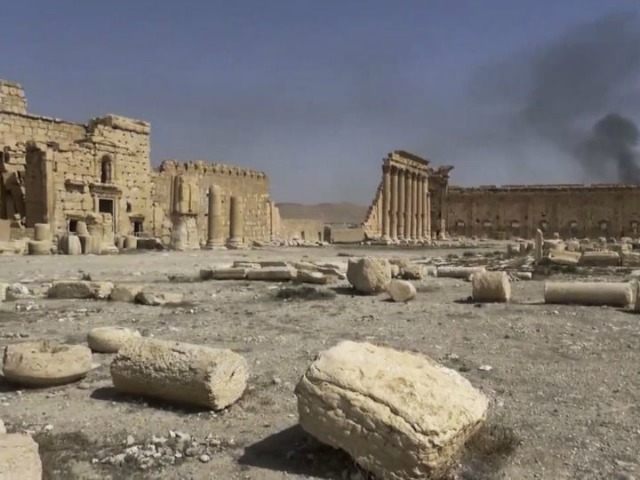The Islamic State (ISIS/ISIL/IS) published pictures of jihadists destroying ancient statues in Palmyra, Syria, a UNESCO World Heritage Site. The terrorist group previously promised not to touch the historical landmarks.
ISIS terrorists annihilate history as they establish their sadistic Caliphate across Iraq and Syria because these pieces promote “idolatry,” according to them. In the pictures, militants use a sledgehammer to obliterate the priceless artifacts. Maamoun Abdelkarim, Syria’s antiquities director, confirmed ISIS destroyed the 2,000-year-old statue Lion of al-Lat. A Polish archaeological team discovered the statue in 1977.
“IS members on Saturday destroyed the Lion of al-Lat, which is a unique piece that is three metres [10ft] tall and weighs 15 tonnes,” he declared. “It’s the most serious crime they have committed against Palmyra’s heritage.”
The “god lion” statue dated back to the first century AD. The lion stood guard at the Temple of Bel in Palmyra. The temple was dedicated to the god Bel, who was worshiped with Aglibol and Yarhibol. The lion, however, was dedicated to Al-lāt, an Islamic goddess for “Springtime and Fertility, the Earth-Goddess who brings prosperity.” She is often identified with goddesses Al-Uzzā and Menāt, who are sometimes referred to as the daughters of Allah. Herodotus, a Greek historian, equated her with Aphrodite, while others placed her next to Athena. She is known as “the Mother of the Gods” or the “Greatest of All.”
The terrorists destroyed six statues in Aleppo, Syria, because they caught ISIS members smuggling the artifacts.
“An IS checkpoint in Wilyat arrested a person transporting several statues from Palmyra,” stated ISIS. “The guilty party was taken to an Islamic court in the town of Minbej, where it was decided that the trafficker would be punished and the statues destroyed.”
ISIS captured Palmyra on May 21. Abdulkarim told the media his department rescued as many pieces as they could from Palmyra’s museum. However, officials and authorities could not do anything about the temples and buildings in Palmyra that earned the city a UNESCO stamp of approval.
“Before taking control of the city [by ISIS], a large number of the items were moved into Damascus, but thousands of the ancient items and sites still remain inside the city,” he announced. “Many are heavy and big, so difficult to relocate.”
Palmyra, 134 miles north of Damascus, is considered an oasis, surrounded by beautiful palm trees. The city first appeared in record in 2000 BC, but became very important under the control of the Roman Empire:
It grew steadily in importance as a city on the trade route linking Persia, India and China with the Roman Empire, marking the crossroads of several civilisations in the ancient world. A grand, colonnaded street of 1100 metres’ length forms the monumental axis of the city, which together with secondary colonnaded cross streets links the major public monuments including the Temple of Ba’al, Diocletian’s Camp, the Agora, Theatre, other temples and urban quarters. Architectural ornament including unique examples of funerary sculpture unites the forms of Greco-roman art with indigenous elements and Persian influences in a strongly original style. Outside the city’s walls are remains of a Roman aqueduct and immense necropolises.
“The destruction is their way of getting back at us [in the West],” explained Clemens Reichel, curator of Mesopotamia at the Royal Ontario Museum. “They know how much we value these historic places.”
Even though the historical pieces are forbidden in their eyes, ISIS does not destroy everything in its path. They sell quite a bit on the antique black market. These sales pushed the group’s accounts from under $1,000 to billions. The militants control around 4,500 archeological sites. In al-Nabuk, they stole antiques over 8,000 years old, which netted $36 million for the jihadists. Residents and gangs are allowed to loot the shrines, but they must give 20% to 50% of their profits to the Islamic State.
“There is no doubt that looting and illicit trade in antiquities is highly lucrative, enough for ISIS to be deeply engaged and implicated in it,” said Shawnee State University Professor Amr Al-Azm. “Stopping this illicit trade in antiquities, therefore, must be an imperative, not only because it is a major source of income for terrorist organizations like ISIS, but also because it is causing irreparable damage to Syria’s cultural heritage.”
Palmyra is at least the fourth UNESCO World Heritage Site that ISIS destroyed. Since then, UNESCO Director General Irena Bokova continues to plead to the international community to step in and save history. After ISIS attacked Hatra and Nimrud, Bokova released this letter to the Iraq government:
“I condemn in the strongest possible manner the destruction of the archaeological site of Nimrud site in Iraq. This is yet another attack against the Iraqi people, reminding us that nothing is safe from the cultural cleansing underway in the country: it targets human lives, minorities, and is marked by the systematic destruction of humanity’s ancient heritage,” said UNESCO Director General Irina Bokova.
We cannot remain silent. The deliberate destruction of cultural heritage constitutes a war crime. I call on all political and religious leaders in the region to stand up and remind everyone that there is absolutely no political or religious justification for the destruction of humanity’s cultural heritage.
“The destruction of Hatra marks a turning point in the appalling strategy of cultural cleansing under way in Iraq,” she said.

COMMENTS
Please let us know if you're having issues with commenting.